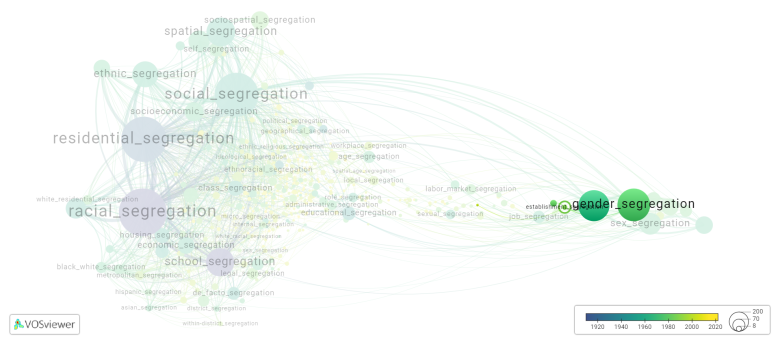Establishment segregation
Date and country of first publication[1][edit | edit source]
1995
United States
Definition[edit | edit source]
Establishment segregation refers to the practice of separating facilities, businesses, or institutions based on race, ethnicity, religion, or other discriminatory factors. It typically involves the denial of access to certain establishments or services to individuals from marginalized or minority groups.
Historically, establishment segregation was prevalent in many countries, particularly during periods of racial and ethnic discrimination, such as African Americans in the United States during the Jim Crow era or apartheid in South Africa. Examples of establishment segregation include separate schools, restrooms, drinking fountains, transportation, restaurants, and other public facilities for different races or ethnicities.
While establishment segregation has been legally abolished in many countries, its effects continue to persist, particularly in social and economic disparities. Efforts to address and eliminate establishment segregation include anti-discrimination laws, affirmative action policies, and public awareness campaigns promoting inclusivity and equal access to all establishments and services.
Synonyms[edit | edit source]
The following terms are synonymous with establishment segregation:
establishment level segregation.
References and literature addressing this segregation form under these synonymous terms can be found below.
See also[edit | edit source]
Related segregation forms[edit | edit source]
Establishment segregation is frequently discussed in the literature with the following segregation forms:
occupational segregation, gender segregation, industrial segregation, sex segregation, occupation establishment segregation, vertical segregation, social segregation

This visualization is based on the study The Multidisciplinary Landscape of Segregation Research.
For the complete network of interrelated segregation forms, please refer to:
References[edit | edit source]
Notes[edit | edit source]
- ↑ Date and country of first publication as informed by the Scopus database (December 2023).
At its current state, this definition has been generated by a Large Language Model (LLM) so far without review by an independent researcher or a member of the curating team of segregation experts that keep the Segregation Wiki online. While we strive for accuracy, we cannot guarantee its reliability, completeness and timeliness. Please use this content with caution and verify information as needed. Also, feel free to improve on the definition as you see fit, including the use of references and other informational resources. We value your input in enhancing the quality and accuracy of the definitions of segregation forms collectively offered in the Segregation Wiki ©.
Establishment segregation appears in the following literature[edit | edit source]
Petersen T., Morgan L.A. (1995). Separate and unequal: occupation establishment sex segregation and the gender wage gap. American Journal of Sociology, 101(2), 329-365. https://doi.org/10.1086/230727
Petersen T., Morgan L.A. (1995). Separate and unequal: occupation establishment sex segregation and the gender wage gap. American Journal of Sociology, 101(2), 329-365. https://doi.org/10.1086/230727
Petersen T., Snartland V., Becken L.-E., Olsen K.M. (1997). Within job wage discrimination and the gender wage gap: The case of Norway. European Sociological Review, 13(2), 199-213. Oxford University Press.https://doi.org/10.1093/oxfordjournals.esr.a018212
Petersen T., Milgrom E.M.M., Snartland V. (2003). THE WITHIN JOB GENDER WAGE GAP, SWEDEN 1970 1990. Research in the Sociology of Organizations, 20(), 319-353. JAI Press.https://doi.org/10.1016/S0733-558X(02)20012-9
Leping K.-O., Toomet O. (2008). Emerging ethnic wage gap: Estonia during political and economic transition. Journal of Comparative Economics, 36(4), 599-619. https://doi.org/10.1016/j.jce.2008.08.002
Campos-Soria J.A., Ortega-Aguaza B., Ropero-García M.A. (2009). Gender segregation and wage difference in the hospitality industry. Tourism Economics, 15(4), 847-866. IP Publishing Ltd.https://doi.org/10.5367/000000009789955152
Campos-Soria J.A., Ropero-García M.A. (2016). Gender segregation and earnings differences in the Spanish labour market. Applied Economics, 48(43), 4143-4155. Routledge.https://doi.org/10.1080/00036846.2016.1153789
Campos-Soria J.A., Ropero-García M.A. (2016). Occupational Segregation and the Female Male Wage Differentials: Evidence for Spain. Gender Issues, 33(3), 183-217. Springer New York LLC.https://doi.org/10.1007/s12147-015-9148-z
Fuller S. (2018). Segregation across workplaces and the motherhood wage gap: Why do mothers work in low wage establishments?. Social Forces, 96(4), 1443-1476. Oxford University Press.https://doi.org/10.1093/sf/sox087
Ferguson J.-P., Koning R. (2018). Firm Turnover and the Return of Racial Establishment Segregation. American Sociological Review, 83(3), 445-474. SAGE Publications Ltd.https://doi.org/10.1177/0003122418767438
